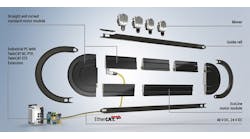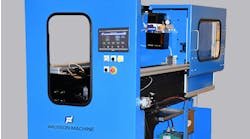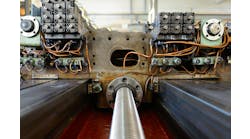Supplying clean, dry air is an important starting point to long and reliable valve operation in industrial machines and equipment. However, switching the air through the proper type of valve to control the cylinder, actuator or air motor is where is where fluid power is controlled.
Pneumatics are a great choice for many machine linear and rotary applications. Unless the machine requires accurate, programmable motion-positioning electric motors or the high-force capabilities of hydraulics, a pneumatic solution is often the best and most popular choice. Instead of electricity, design in some pneumatic air preparation hardware, tubing, valves, solenoids and flow controls, connect to the pneumatic cylinders, actuators and motors and get the machine moving.
Clean and dry
Even though most manufacturing has filtered and dried air flowing through its plant air distribution system, it is a best practice to include air preparation on every machine. Not only does it protect plant floor personnel, it protects the equipment from dirt, moisture and debris.
Include a manually operated and lockable shutoff valve, particulate filter, water trap and pressure regulator with gauge on each machine. This air prep assembly should also include an electrically operated soft-start valve to quickly remove machine air under an emergency stop or other unsafe machine condition. This soft-start valve will also slowly and safely re-pressurize the machine when energy is restored.
Also read: How machine monitoring can yield energy savings on compressors
These air prep systems, in the past, often included lubricators, which added oil mist to the compressed air. These should be used sparingly, if at all, since most pneumatic devices don't require lubrication today, but there are exceptions, such as air tools.
The air prep also should adjust the plant air supply pressure. While 100 psi or more is often distributed throughout the plant, machines typically require only 60 to 80 psi. Because of air pressure fluctuations and the possible adverse effects on the machine, include a pressure gauge and digital air pressure switch to keep the personnel and controller aware of the air pressure supplied.
Control the fluid
Once the proper machine air prep is specified with the required flow and pressure, the focus shifts to the mechanical motion, such as positioning, clamping, lifting and gripping. To control this mechanical motion, the proper valve must be specified.
Before specifying the power transmission device such as an air cylinder, with the help of your favorite pneumatic hardware vendor, there are questions you should know the answers to—unless you just want to guess, which may work. The questions are:
- What is the mass that will be moved, or how much force do you want to hold on the part?
- How fast do you want to move?
- What motion profile do you want—acceleration/deceleration?
There are also mechanical considerations such as the need for guided actuators, space constraints and mounting configurations.
How the fluid power transmission hardware is used determines the type of valve controlling air to the device. Choices for valve activation include manual, direct solenoid-operated and air-piloted solenoid. These valve actuators control a variety of common pneumatic valve types including two-, three- and four-way, two-position valves and four-way, three-position valves. What the valve is controlling strongly defines the valve type, or configuration, selected for the application.
The two-way, two-position valve can be thought of as a normally open or normally closed relay depending on its output when not energized. A three-way, two-position valve is very similar to normally open/normally closed relay. These are common in on/off applications such as an air nozzle, air motor or a supply/drain application.
When the valve is required to control a cylinder or actuator that extends and retracts, a four-way, two-position or three-position valve is required. In these applications, the air must be both supplied and exhausted from the motion-causing device. One side of the cylinder is pressurized, while, on the other side, air is being exhausted.
Keep in mind that, with two-position valves, the cylinder is either extending or retracting when air is applied—there is not a third position for the air to the cylinder to be exhausted or pressurized, on both sides of the cylinder, when the solenoids controlling the valve are turned off. These two-position valves are typically detent, so the valve spool maintains position through a power-off-to-power-on transition. If the cylinder is moving when air was turned off, it will start moving again as soon as air is reapplied after an emergency stop, for example.
With a four-way, three-position valve, the center position air is either exhausted, typically through a muffler, or blocked, trapping air in the cylinder, when both solenoids are de-energized. This configuration can be more complicated to control and cause fast cylinder motion due to no air for a flow control function to control cylinder speed. It can also cause a safety issue by trapping air in a cylinder causing unexpected motion under an emergency stop condition.
Get to know proper air prep and valve configuration for your machines. And, while you are at it, learn the pneumatic schematic symbols as they define the number of valve positions and ports, how air and exhaust flow through the valve and how the valve is actuated. These are all critical requirements for specifying the proper valve.






